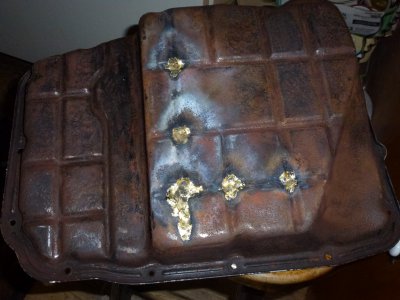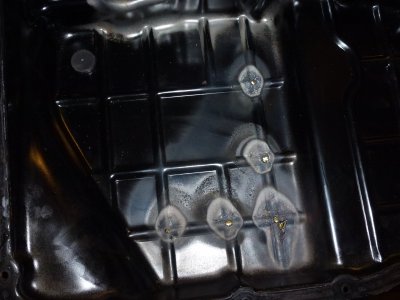- Joined
- Feb 7, 2013
- Messages
- 2,533
The Jeep Laredo started leaking oil from the automatic transmission pan so had to take action.
The easy way to remove the pan without a big mess is to stab the leaking spot with an ice pick
to drain the oil from the transmission. After the oil was drained, it was an easy job to remove
the bolts holding the pan. The pan was pretty crusty and required a lot of cleaning as it was
coated with road salt and sand, an ugly mess. Here in Minnesota the powers that be seem to
think that salt and sanding everywhere is a necessity for which completely disagree. I much prefer
to drive on a snowy salt free road myself. Unfortunately, it doesn't happen very often though.
Unfortunately, it doesn't happen very often though.
The repair was pretty easy and I found a few weak spots with the ice pick and did a bit of brazing
using some boric acid flux and brass rods and using a slightly carburizing flame. Inside the
transmission is an oil filter so I ordered a new filter on line. The outside of the transmission
case will get a coat of Rustoleum Rust Reforming paint and also a top coat of regular paint.
Here's a couple photos of the repair work, the first photo of the outside of the pan and the second photo of the
inside.
The Laredo is full time 4 wheel drive so worth getting it roadworthy again. It's my spare car I keep just for an
emergency. The prediction for the coming months are for heavy amounts of snow so it is added insurance
that I can get around.
The easy way to remove the pan without a big mess is to stab the leaking spot with an ice pick
to drain the oil from the transmission. After the oil was drained, it was an easy job to remove
the bolts holding the pan. The pan was pretty crusty and required a lot of cleaning as it was
coated with road salt and sand, an ugly mess. Here in Minnesota the powers that be seem to
think that salt and sanding everywhere is a necessity for which completely disagree. I much prefer
to drive on a snowy salt free road myself.
 Unfortunately, it doesn't happen very often though.
Unfortunately, it doesn't happen very often though.
The repair was pretty easy and I found a few weak spots with the ice pick and did a bit of brazing
using some boric acid flux and brass rods and using a slightly carburizing flame. Inside the
transmission is an oil filter so I ordered a new filter on line. The outside of the transmission
case will get a coat of Rustoleum Rust Reforming paint and also a top coat of regular paint.
Here's a couple photos of the repair work, the first photo of the outside of the pan and the second photo of the
inside.
The Laredo is full time 4 wheel drive so worth getting it roadworthy again. It's my spare car I keep just for an
emergency. The prediction for the coming months are for heavy amounts of snow so it is added insurance
that I can get around.


